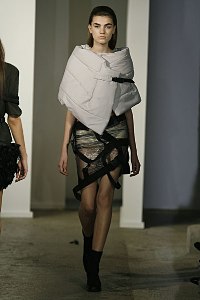Shigeru Ban, Curtain Wall House, 1995. Shigeru Ban Architects, Itabashi, Tokyo, Japan Photo © Hiroyuki Hirai
Unfortunately, the groundbreaking exhibition “Skin and Bones: Parallel Practices in Fashion and Architecture” at the Museum of Contemporary Art in Los Angeles is now over. Thus, this post is dedicated to those who were not lucky enough (like me) to have had the opportunity to experience the visual discourse between fashion and architecture as developed by MOCA's Curator of Architecture & Design, Brooke Hodge.
Brooke graciously took a moment to talk to Fashion Projects about the relationship between these two disciplines and her inspirations in developing the exhibition. After reading this brief interview, head to FIT on April 18th to hear a panel discussion featuring Brooke Hodge, Patricia Mears (Deputy Director of the Museum at FIT and contributor to the Skin and Bones catalog) and others discuss fashion and architecture. More information follows this interview. FP: You write that you explicitly realized the connections between fashion and architecture when you were curating a show on Rei Kawakubo of Comme des Garçons. What was it about her designs that got you thinking of the parallels between these two disciplines? In general, how important do you think the Japanese designers (Miyake, Yamamoto, Watanabe, etc.) are to this concept?
BH: When I was working on the Comme des Garçons show, I started to notice that the clothes were described using terms usually applied to architecture—structural, constructed, architectonic, sculptural, etc. This got me curious about other parallels.
I think the work of the Japanese designers, especially Yamamoto, Kawakubo, and Miyake, is very important to the idea that there are parallels between fashion and architecture. Yamamoto and Kawakubo were the first designers to explore ideas of deconstruction in their garments (in 1982) and to create clothes that were radically different from what we had been accustomed to and from what other designers were doing at the time. Miyake’s sculptural shapes and innovations with pleating have also been very influential for architects, especially Frank Gehry. Junya Watanabe’s influence is more recent but still very important.
While it is true that the point of origin for both fashion and architecture is the three-dimensional body, do you think that the vastly different scales and sense of permanence make for an antagonistic relationship?
I think that for many years architects considered fashion to be frivolous and superficial. However, with the rise to prominence of more intellectual designers like the Japanese designers mentioned above, I think architects have more respect for fashion and realize that there is inspiration to be gleaned from it. Both use flat materials to make volumetric forms. With the increased potential to make more complex curved forms in architecture, thanks to computer-aided design, architects are looking more to fashion for construction techniques that will enable them create more interesting surfaces and to shape more complex forms. I think there is still a little snobbery on the part of architects toward fashion because architecture is much more monumental and meant to last many years and fashion is still seen as something that changes every season. It’s interesting that several architects have experimented with ideas on the scale of clothing (Diller + Scofidio, J. Meejin Yoon, Elena Manferdini, to name a few) because it is an easier scale to work with and quicker and less expensive to complete something. In the case of Manferdini, these experiments in the area of fashion have been important for her architecture practice. The pavilion she designed for the Beijing Biennale incorporated the process, tools, and motifs she has worked with in her clothing designs.
You state that the two main characteristics that fashion and architecture share are minimalism and deconstruction? In your mind, which characteristic bears the most fruitful dialogue?
Minimalism and deconstruction are two main STYLISTIC characteristics that fashion and architecture share but there are other important parallels. Deconstruction created the most important dialogue in terms of “style” since it had more impact in terms of creating potential for new forms of expression in both and was a much more radical shift in both fields. They both address basic human needs such as shelter and identity. I think the most fruitful dialogue is in the area of techniques of construction that are being adopted and adapted across the two disciplines.
The parallels between fashion and architecture are easily accepted by fashion scholars, perhaps in part because it lends a sophisticated legitimacy to a field known for its whims. However, do you think that the links between these two fields are as readily accepted (and desired) by architects and their critics?
I get the feeling that architecture critics (and some architects) are not yet ready to accept that there may be parallels between the two fields. This may be due to the snobbery toward fashion mentioned above. Also those who are less visually inclined may not be able to discern visual similarities between the two. None of the architects I contacted for the exhibition were reluctant to include their work in the show and most were very enthusiastic and mentioned their interest in fashion. “Skin and Bones” is not the first exhibition to highlight the connections between fashion and architecture. In 1982 there was a groundbreaking exhibition at MIT titled “Intimate Architecture: Contemporary Clothing Design” curated by Susan Sidlauska. And this past year at the Center for Architecture in New York there was an exhibition titled “The Fashion of Architecture: Constructing the Architecture of Fashion," curated by Bradley Quinn. How is “Skin and Bones” different from these past exhibtions?
Intimate Architecture was a definite inspiration for me. However, it did not include architecture—only garments that are architectural. The Fashion of Architecture was interesting in terms of the fashion it included but it too did not include much architecture at all. It also had an emphasis on fashion created by artists as well as some examples of clothes created by architects or by architects in collaboration with fashion designers. Skin + Bones is the first exhibition to examine the relationship between fashion and architecture in great depth with numerous examples from both fields.
A more recent connection between fashion and architecture is in the area of sustainability. Many fashion designers are following the lead of architects by attempting to use more ecological materials and processes. What do you think of this emerging parallel? Are there any other areas that you see emerging as a new dialectic between these two disciplines?
It would be great to see both fashion designers and architects truly use sustainable materials in a meaningful way that is accepted by the public. I think Testa & Weiser’s work with architectural applications for carbon fiber has a lot of potential for the future. I think architects are currently looking more at fashion and maybe we will see fashion begin to look at architecture more for inspiration.
Interview by Sarah Scaturro
Visit www.moca.org to download the Skin and Bones Gallery Guide, featuring photos of the objects as well as the didactic material appearing in the exhibition. Unfortunately, the gorgeous hardcover catalog accompanying the exhibition is sold out in many major online retail shops. If you see it, snatch it up quickly.
------------------------------------------------
“SKIN + BONES: Parallel Practices in Fashion and Architecture”
Panel Discussion
Wednesday, April 18
6:00pm – 8:00pm
Fashion Institute of Technology, 27th St. at 7th Avenue, NYC
Katie Murphy Amphitheatre, Fred P. Pomerantz Art and Design Center (D building), 1st floor
$25 general admission, $17 for students and seniors. Free to FIT students, faculty, and staff.










